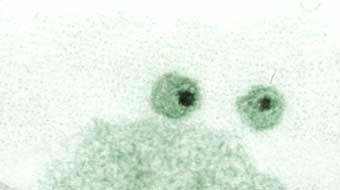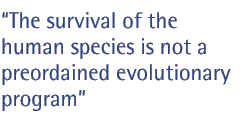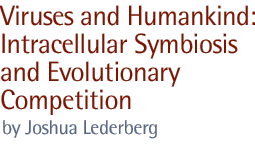
The first photo ever taken of the human immunodeficiency virus (HIV).
A 1989 speech by Joshua Lederberg. He won the Nobel Prize in 1958 for his work in bacterial genetics.
In this speech that Dr. Lederberg gave before an audience of scientists studying the biology of viruses, he warns against complacency in the age-old contest between mankind and microbes -- viruses and bacteria. He lays out why man's "only real competitors remain the viruses," and explains how all terrestrial life is a dense web of mutualism and genetic interactions; there are abundant sources of genetic variation "for viruses to learn new tricks, not necessarily confined to what happens routinely or even frequently."
- Glossary
- antibiosis - an association between two or more organisms that is detrimental to at least one of them
- antigenic evolution - antigens are substances (toxins, bacteria, foreign blood cells) introduced into the body that stimulates the production of an antibody
- biosynthetic - pertaining to living organisms' production of chemical substances
- cytogene - a self-replicating cytoplasmic gene
- eukaryotic cell - a cell with a true nucleus
- immunoglobulin genes - genes influencing the making of antibodies in the immune response
- leukemogenic - pertaining to the causation and development of leukemia
- microbes - living organisms that can be seen only through a microscope, including bacteria, protozoa, viruses and fungi
- mitochondria - a structure in most cells containing enzymes needed for metabolic process
- myxoma virus in Australia - closely related to the smallpox virus, the myxoma virus was released in Australia in the 1950s and dramatically reduced the rabbit population
- neurotropism - an affinity for tissues of the central nervous system
- pathogenic - disease causing
- phenotypic - pertaining to observable physical or biochemical characteristics of an organism, as determined by genetic makeup and environmental influences
- plasmid - a double-stranded unit of DNA that replicates within a cell independently of the chromosomal DNA; plasmids are used in recombinant DNA research to transfer genes between cells
- synecology - the study of the ecological interrelationships among communities of organisms
- trypanosomes - various parasitic protozoans transmitted to the vertebrate bloodstream, lymph and spinal fluid by certain insects, often causing disease such as sleeping sickness and nagana
- vector - an organism that transmits parasites, viruses or bacteria from one host to another
...Some of Steve [Morse]'s first words were that we are ever vigilant. I wish that were true. And Dick said, we just had to sit back and wait. I am afraid that from the point of view of public policy and the major health establishments of the world, that is much more closer to their reaction, even to this day, to the prospects of emergent disease.
Fortunately, in this room, we have the investigators who are the most preoccupied with the biology of viruses, who have a very personal and intimate acquaintanceship with how they tick and are therefore much more sensitive to their potentialities for evolutionary change [in] the evolution of their symbiotic relations with their hosts. Never has there been a more concentrated collection of intellect devoted to that kind of question.
I am deeply gratified at the number and quality of investigators who have responded to the call for this symposium. I do marvel that the present examination is virtually without precedent. Of course, many symposia on viruses cover every aspect of their biology and epidemiology. For the most part, these have been sharply focused on particular categories, whether of the host, the vectors, or the taxonomic location of the virus itself. But the historiography of epidemic disease is one of the last refuges of the concept of special creationism, with scant attention to dynamic change on the part of the agents of disease.
It is not hard to imagine the sources of resistance to these evolutionary concepts. It is scary to imagine the emergence of new infectious agents as threats to human existence, especially threatening to view pandemic as a recurrent, natural phenomenon. In reaction to the daunting pace of technological change and the sudden alteration of balance, the natural has been extolled. In 50 years, the earth has become so small on the scale of technological alterations of the environment; the atmosphere, the oceans, our aquifers are no longer infinite sinks. Many people find it difficult to accommodate to the reality that Nature is far from benign; at least it has no special sentiment for the welfare of the human versus other species. Those who are horrified at any tinge of our "tampering with natural evolution" need to be reminded that this has been intrinsic to human culture since Prometheus: the invention of fire, of agriculture, of language, of human settlements, of an overall peopling of the planet perhaps a thousand-fold denser than we had been evolved for -- not to mention a sudden doubling of life span in our century that leaves the latter half of it beyond the scope of what had ever been shaped by natural selection. So contemporary man is a manmade species. In a biological sense, we may achieve new genomic equilibria with these radically altered environments; but the price of natural selection is so high that I doubt we would find it ethically acceptable: it conflicts violently with the nominally infinite worth that we place on every individual. So we have drastically tampered with human evolution, in large measure by suspending that process in favor of artifice.
That artifice has of course been the greatest threat to every other plant and animal species, as we crowd them out in our own quest for Lebensraum. A few vermin aside, Homo sapiens has undisputed dominion -- and we could, where we choose, even eradicate rodent and insect pests in confined areas we chose to make oligoxenic at the expense of some of the birds and the bees and some marginal chemical poisoning of ourselves, and an irrevocable loss of evolutionary diversity among the species, an eventual narrowing of the options for our own survival.

Bacterial and protozoan parasites linger a bit longer; but they do have distinctive metabolism, and our ingenuity in devising antibiotics can be expected to outpace theirs in evolving resistance (albeit not without some struggle) provided only that we apply the needed technological resources. And for the most part, still more appropriate technologies of hygiene and vaccination will do most of the job. Our only real competitors remain the viruses; for it is by no means clear that antiviral antibiosis can generally be achieved in principle: the very essence of the virus is its fundamental entanglement with the genetic and metabolic machinery of the host.
Our main recourse has been prophylactic vaccination; and for a number of viruses this will surely work, though very few share the idiosyncrasies of variola (smallpox) that made it the most rational target for our initial effort at global eradication, at an evolutionary victory of the first order. But as we find in abundance, many viruses are more adroit than variola in antigenic evolution, and we shall have to be very nimble indeed to keep up with the diversification of influenza, particularly when we get recurrence of more lethal strains, such as neurotropism already well known in bird strains.
Other viruses will adapt by changes of range of host or of vector -- the more threatening as we know so little of the biochemical bases of that specificity. And some vector-borne agents will surely learn the tricks of direct aerosol transmission, as has been claimed for pneumonic transmission of bacterial plagues. Why not? For the few antiviral drugs now available, we are, of course, already seeing the emergence of resistant viral strains, just as with bacteria. The viruses I know best, the bacteriophages, are of course no threat to public health. They may occasionally be pests in the fermentation industry; D'Herelle (and Martin Arrowsmith, the hero of Sinclair Lewis' novel) once thought they might have some merit in therapeutics. They have conveyed to me dramatic images of the wipeout of large populations, sometimes as the result of host range mutations. They have also taught us a great deal about the basic biology of viruses, lessons that can be extrapolated first hand -- for example, the transduction of host genes by viruses, and the integration of viral genomes into the host chromosomes. The intrinsic hypervariability of certain categories of viruses is often mentioned; and we know this will be aggravated further in maladjusted genetic complexes. It is after all genetic stability that has had to be meticulously evolved; we will see mutation rates as high as are compatible with generational viability when the regulatory controls are disrupted. The vertebrate immune system illustrates how the hypermutability of immunoglobulin genes is a trick relearned in evolution -- and matched by the trypanosome's versatility in varying its surface antigens.
Our view of virus as a parasite is complicated by that of a virus as a genetic element, a two-way channel. The viruses are routinely subject to phenotypic modification by the host cells and, from time to time, the viruses incorporate host genes in their standard genomes and vice versa.
This view still looks at host and parasite as independent and autonomous genetic systems. Let us examine their relationship still more broadly.
When we try to classify the genetic elements within cells we find a continuum, with the nucleus and its macrochromosomes at one pole, a range of other particles in between, and the frank extraneous cytocidal and cytolytic viruses at the other. Even among the chromosomes, especially in plants, we find micro- or B chromosomal elements that share every attribute of a parasite except that they show vertical transmission rather than routine lateral mobility; they also differ in their highly attenuated pathogenicity.
Other particles occupy the cytoplasm. We know most of all today about the mitochondria and the chloroplasts. The eukaryotic cell is now recognized as a symbiosis, those elements very likely having been evolved from what were once free living microbes. lndeed, it is not difficult to cure yeast of their mitochondria with acriflavine, and Chlamydomonas and other green plant cells of their chloroplasts with streptomycin.
Conversely, we know of many "viruses" in plants and animals that display vertical transmission. These include the rodent leukemogenic viruses and, close by, the mouse mammary tumor milk factor (now called mouse mammary tumor virus), and abundant examples in plants. It will be astounding if we were not to find still other viruses that have become routinized as cytoplasm organelles in parallel with the mitochondrial and chloroplast systems, like some of the endosymbiotic bacteria of insects that have become indispensable to the normal economy of their specific host.
At one time much polemical energy was spent arguing whether some of these entities were viruses, on the one hand, or cytogenes on the other, as if these were disjunctive concepts. The word plasmid was invented in 1952 to help moot a logically empty controversy (Lederberg, 1952). The expression has come to be used mainly in the narrower sense of the small circular DNAs that abound in bacteria (it is hard to find bacteria that don't have them). However, it was intended to apply as well to mitochondria and to temperate viruses. We are going to discover many, many more entities like that in the cytoplasm of eukaryotic cells as well (Gaubatz, 1990).
To look still more broadly, we discovered that terrestrial life is a dense web of genetic interactions. The plant cell is an intracellular symbiosis, the photosynthetic chloroplast fixing solar energy for the benefit of the host. And I will not take time to articulate how the tree repays that debt. Then, when I eat a green plant and sow its seeds, our genetic systems are also interacting to mutual benefit. The lichen is not much different: that the cell boundaries are likewise still intact between algae and fungus. One can find intermediate interactions, even across broad species lines, of hyperparasitism, the nuclei of one fungus parasitizing the cytoplasm of another. This blends into heterokaryosis within a species, with the regular dikaryons (cells with two nuclei) of the Basidiomycetes, the mushrooms. In the laboratory there is an easy and elegant demonstration of nutritional symbiosis of complementary auxotrophic mutants in heterokaryons. Each mutant separately is unable to grow because each requires a nutrient that it cannot make; together, each of the two nuclei placed into one cell provides the genetic information needed by the other, and the hybrid cell can grow. In streptomycetes it is difficult to distinguish these internuclear interactions from chromosomal ones.
We can thus see the continuum of interaction of genetic systems we have coevolved. There is a synecology at the very top level that is absolutely undeniable, the exchange of what are ultimately gene products, the metabolites, the energy that is fixed in green plants. Syncytia -- fused cells -- form more abundantly than most people realize where these interactions become possible at a more intimate level, and one can see polymers, enzymes, RNA messages, and so on as the units. And then synkaryosis, the primitive step in sexual recombination, is a further step in that continuum. Consider further the interrelationships of still smaller autonomous genetic elements like viruses and plasmids, and mitochondria, as falling at different points on this spectrum with no sharp line between them (Margulis and Fester, 1991).
This pattern of mutualism must have prevailed from the very earliest stages of biosynthetic evolution, perhaps even prior to the organization of the cell as we now know it. The recombination of self-replicating molecules to facilitate biosynthetic complementation would have accelerated primitive chemical evolution from the earliest times.
Refocusing on the pathogenic interactions, we recall that since Frank Macfarlane Burnet (Burnet and White, 1972), Theobald Smith (1939), and others, we have understood that evolutionary equilibrium favors mutualistic rather than parasitic or unilaterally destructive interactions. Natural selection, in the long run, favors host resistance, on the one hand, and temperate virulence and immunogenic masking on the parasite's part on the other. But I garner limited assurance from those precedents. Yes, demographic obliteration is not the most likely outcome of a novel introduction or the emergence of a major new virus. Most likely, the outcome of those exigencies will not be worse than what happened to the rabbits in Australia after the introduction of myxoma virus.
But apart from the personal human catastrophe that such a pandemic would entail (short of prompt species obliteration), I would also question whether human society could survive left on the beach with only a few percent of survivors. Could they function at any level of culture higher than that of the rabbits? And, if reduced to that, would we compete very well with kangaroos?
Let me summarize: the units of natural selection are DNA, sometimes RNA elements, by no means neatly packaged in discrete organisms. They all share the entire biosphere. The survival of the human species is not a preordained evolutionary program. Abundant sources of genetic variation exist for viruses to learn new tricks, not necessarily confined to what happens routinely or even frequently. The first inklings that genetic recombination could occur at all in bacteria, in F+ E. coli, were at a rate of 10-7, or one in ten million, and one had to look very hard to have any evidence that they existed at all. And some bamboo plants flower only once per century and the careless observer might think that they never recombine. Some generalizations to the limits of genetic change in viruses are equally hasty.
REFERENCES
Burnet, F.M., and D.O. White (1972). Natural History of Infectious Disease, fourth ed. Cambridge: Cambridge University Press.
Gaubatz, J.W. (1990). Extrachromosomal circular DNAs and genomic sequence plasticity in eukaryotic cells. Mutat. Res. 237:271-292.
Lederberg, J. (1952). Cell genetics and hereditary symbiosis. Physiol. Rev. 32:403-430.
Margulis, L., and R. Fester (eds.) (1991). Symbiosis as a Source of Evolutionary Innovation: Speciation and Morphogenesis. Cambridge, Mass.: MIT Press.
Smith, T. (1939). Parasitism and Disease. Princeton: Princeton University Press.
